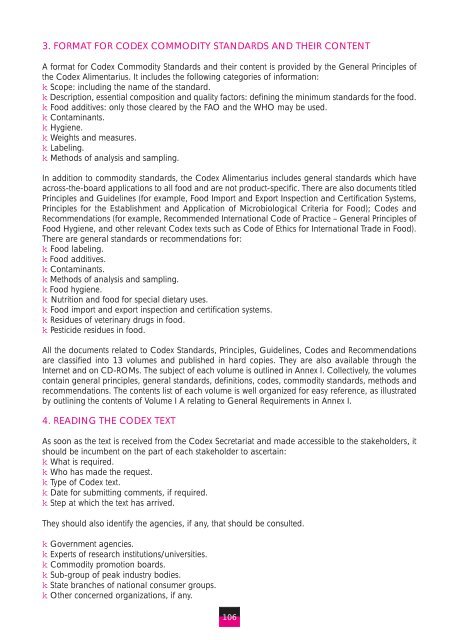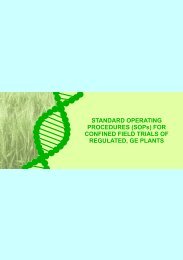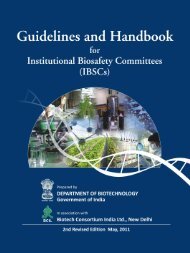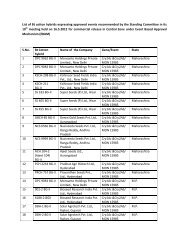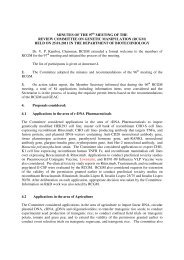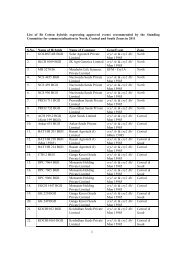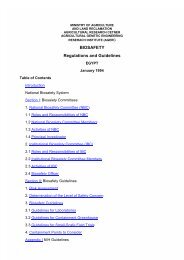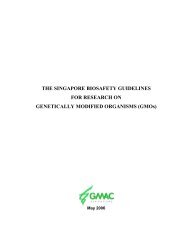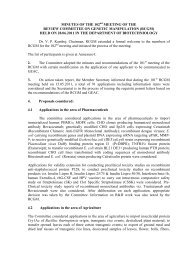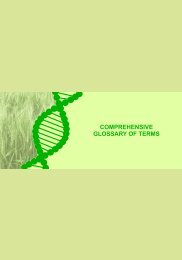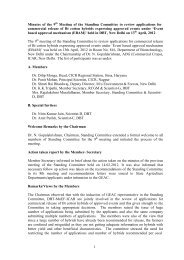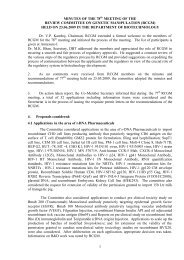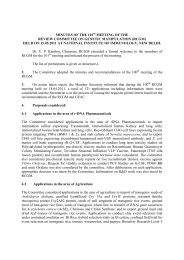THE USER'S MANUAL ON CODEX - Department of Biotechnology
THE USER'S MANUAL ON CODEX - Department of Biotechnology
THE USER'S MANUAL ON CODEX - Department of Biotechnology
Create successful ePaper yourself
Turn your PDF publications into a flip-book with our unique Google optimized e-Paper software.
3. FORMAT FOR <strong>CODEX</strong> COMMODITY STANDARDS AND <strong>THE</strong>IR C<strong>ON</strong>TENT<br />
A format for Codex Commodity Standards and their content is provided by the General Principles <strong>of</strong><br />
the Codex Alimentarius. It includes the following categories <strong>of</strong> information:<br />
k Scope: including the name <strong>of</strong> the standard.<br />
k Description, essential composition and quality factors: defining the minimum standards for the food.<br />
k Food additives: only those cleared by the FAO and the WHO may be used.<br />
k Contaminants.<br />
k Hygiene.<br />
k Weights and measures.<br />
k Labeling.<br />
k Methods <strong>of</strong> analysis and sampling.<br />
In addition to commodity standards, the Codex Alimentarius includes general standards which have<br />
across-the-board applications to all food and are not product-specific. There are also documents titled<br />
Principles and Guidelines (for example, Food Import and Export Inspection and Certification Systems,<br />
Principles for the Establishment and Application <strong>of</strong> Microbiological Criteria for Food); Codes and<br />
Recommendations (for example, Recommended International Code <strong>of</strong> Practice – General Principles <strong>of</strong><br />
Food Hygiene, and other relevant Codex texts such as Code <strong>of</strong> Ethics for International Trade in Food).<br />
There are general standards or recommendations for:<br />
k Food labeling.<br />
k Food additives.<br />
k Contaminants.<br />
k Methods <strong>of</strong> analysis and sampling.<br />
k Food hygiene.<br />
k Nutrition and food for special dietary uses.<br />
k Food import and export inspection and certification systems.<br />
k Residues <strong>of</strong> veterinary drugs in food.<br />
k Pesticide residues in food.<br />
All the documents related to Codex Standards, Principles, Guidelines, Codes and Recommendations<br />
are classified into 13 volumes and published in hard copies. They are also available through the<br />
Internet and on CD-ROMs. The subject <strong>of</strong> each volume is outlined in Annex I. Collectively, the volumes<br />
contain general principles, general standards, definitions, codes, commodity standards, methods and<br />
recommendations. The contents list <strong>of</strong> each volume is well organized for easy reference, as illustrated<br />
by outlining the contents <strong>of</strong> Volume I A relating to General Requirements in Annex I.<br />
4. READING <strong>THE</strong> <strong>CODEX</strong> TEXT<br />
As soon as the text is received from the Codex Secretariat and made accessible to the stakeholders, it<br />
should be incumbent on the part <strong>of</strong> each stakeholder to ascertain:<br />
k What is required.<br />
k Who has made the request.<br />
k Type <strong>of</strong> Codex text.<br />
k Date for submitting comments, if required.<br />
k Step at which the text has arrived.<br />
They should also identify the agencies, if any, that should be consulted.<br />
k Government agencies.<br />
k Experts <strong>of</strong> research institutions/universities.<br />
k Commodity promotion boards.<br />
k Sub-group <strong>of</strong> peak industry bodies.<br />
k State branches <strong>of</strong> national consumer groups.<br />
k Other concerned organizations, if any.<br />
106


